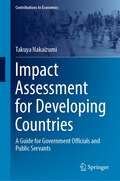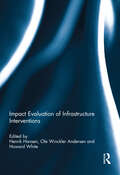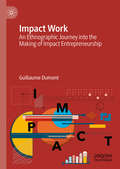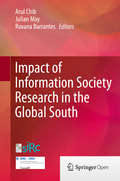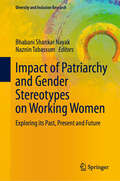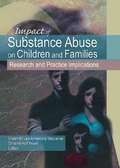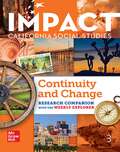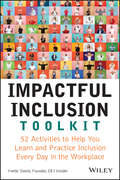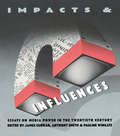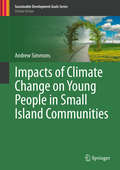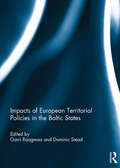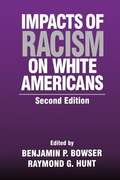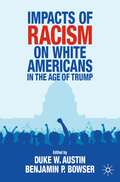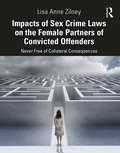- Table View
- List View
Impact Assessment for Developing Countries: A Guide for Government Officials and Public Servants (Contributions to Economics)
by Takuya NakaizumiImpact Assessment (IA) is introduced in this book, with a guide to the process, scope, content, and management of IA for the governments of developing economies. In doing so, evidence-based policy making is taken into full consideration. After the principles of IA are set forth, its procedures are described, illustrated by typical cases from the United States and Japan. Then an explanation follows of the components of IA such as necessity, alternatives, and assessment of cost and benefit, with a description of competition assessment. In developing economies, it is not effective to simply import a system from developed countries directly into developing countries, especially for economic regulation and in consideration of compliance and competition issues. Thus the book provides recommendations on how to appropriately modify developed countries’ systems for countries that are still developing. The book concludes by taking up several issues surrounding IA, especially nudge theory and public involvement.
Impact Evaluation of Infrastructure Interventions
by Howard White Ole Winckler Andersen Henrik HansenThe focus on results in development agencies has led to increased focus on impact evaluation to demonstrate the effectiveness of development programmes. This book illustrates the broad range of methods available for counterfactual analysis of infrastructure programmes such as establishment, rehabilitation and maintenance of roads, water supply and electrical power plants and grids.Understanding the impact of interventions requires understanding of the context in which the intervention takes place and the channels through which it is expected to occur. For infrastructure interventions it is particularly important to identify the links between the input and the outcomes and impacts because the well-being of people, the ultimate impact, does not change directly as a consequence of the intervention. Therefore impact evaluation of infrastructure programmes typically requires mixing both quantitative and qualitative approaches as illustrated in many of the contribution to this edited volume.This book was originally published as a special issue of the Journal of Development Effectiveness.
Impact Social Studies Our Place In The World Grade 1 Research Companion
by McGraw-Hill EducationOur Place In The World Research Companion
Impact Social Studies Regions of the United States Grade 4 Research Companion
by McGraw-Hill EducationImpact; Social Studies, Regions of the United States, Grade 4, Research Companion
Impact Social Studies: Exploring Who We Are
by McGraw-Hill EducationThe Research Companion is a hard-covered text where students investigate Essential Questions, gather evidence, evaluate primary and secondary sources, consider points of view, experience citizenship and understand how the past shapes the present and future.
Impact Social Studies: Impact Explorer Magazine, U.S. History Making a Nation
by McGraw-Hill EducationNIMAC-sourced textbook
Impact Social Studies: Regions of the United States, Research Companion
by William Deverell James Banks Kevin CollearyNIMAC-sourced textbook
Impact Social Studies: U.S. History: Making a New Nation, Grade 5, Research Companion
by William Deverell James Banks Kevin CollearyNIMAC-sourced textbook
Impact Statement: A Family's Fight for Justice against Whitey Bulger, Stephen Flemmi, and the FBI
by Bob HalloranNo one can deny that mob boss James "Whitey" Bulger and Stephen "The Rifleman" Flemmi are two of the most brutal killers in American history—not even the two gangsters themselves. But a jury denied the Davis family closure for the slaying of Debbie Davis, Flemmi's beautiful young girlfriend, who went missing in 1981 and whose remains were found nearly twenty years later under the Neponset River Bridge in Quincy, Massachusetts.Now serving a life sentence, Stephen Flemmi testified in graphic detail how he lured Debbie to a house in South Boston where Bulger jumped out of the shadows and strangled her to death. Flemmi then extracted her teeth and buried her body by the Neponset River while Bulger watched. Bulger wanted Debbie dead, Flemmi claimed, because she knew that the two men were meeting with an FBI agent named John Connolly. That, and he might have been jealous of the time Flemmi and Debbie were spending together. Throughout his trial, Bulger stubbornly insisted that he never would have committed the dishonorable act of killing a woman. In the end, it was one stone-cold murderer's testimony against another's.In Impact Statement, veteran journalist Bob Halloran looks at the devastating impact Bulger and Flemmi have had on the Davis family, whose longstanding relationship with the two mobsters cost them a father, two sisters, and a brother. Through up-to-the-minute coverage of Bulger's criminal trial and extensive interviews with Debbie's brother Steve Davis, a one-time protégé of Flemmi's and now an outspoken advocate for the victims' families, Halloran has pieced together this unique and compelling story of a family's quest for justice.
Impact Work: An Ethnographic Journey into the Making of Impact Entrepreneurship
by Guillaume DumontThis book provides a critical, ethnographically grounded examination of the hype surrounding the idea of impact by investigating the work of those attempting to create innovative social ventures. Through in-depth immersion in the day-to-day running of a social impact accelerator, Guillaume Dumont reveals the intricate, behind-the-scenes socialization through which entrepreneurs learn the ropes of impact entrepreneurship and sheds light on the roles of some of the key players of this unique social world. The book challenges the view that impact is a given property of a venture resulting from an intrinsic desire to change the world embodied by gifted and compassionate entrepreneurs. Instead, Dumont argues that impact emerges iteratively from a process of social engagement and negotiation among entrepreneurs, investors, corporate executives, and mentors as they collaborate in the mundane processes of its production, what he calls “Impact work.” This book, therefore, is about impact in the making. It is a story of hope and collaboration unveiling the social and cultural challenges and contradictions faced by those attempting to create alternative organizations addressing social and commercial goals.
Impact of Climate Change in the Indian Sundarbans Region
by Nabanita Mukherjee Giyasuddin SiddiqueThis book studies climate change vulnerability in the Southern Part of the Indian Sundarbans Region, West Bengal, following the IPCC framework which highlights three prime components of vulnerability - exposure, sensitivity and adaptive capacity. This framework is considered as one of the best methods of vulnerability assessment as it uses direct household perception through collection of primary data, and recognizes a household’s proficiency in maintaining sustainable means of livelihood to deal with climatic changes. This is especially important in gauging the knowledge and perception of local indigenous people on climate change, and determining what measures can be taken to foster informed decision making for improved climate change adaptation and management. The specific impact of climate change on women, their lives and livelihood are also given due attention, as there is little written about gendered vulnerability to climate change in the region. The final chapter elaborates the limits, barriers to adaptation of climate change and also extends site specific suggestions for achieving community resilience in the Indian Sundarbans Region.
Impact of Culture on Management of Foreign SMEs in China (International Series in Advanced Management Studies)
by Bin Shen Rubens PauluzzoThis book describes how a deeper knowledge and understanding of cultural differences represents a meaningful and useful tool for management of companies, and in particular SMEs, in the People’s Republic of China. After introductory chapters on the internationalization of SMEs and the role played by management in this process, the authors explore the implications of academic discourses on culture and its dimensions for company management. The influence of Chinese cultural roots and the country’s current cultural environment on management is then examined, with provision of guidance on response to the identified challenges. A key feature of the book is the presentation of important recent fieldwork in the main economic regions of China. This research further clarifies how business culture and cultural differences impact on company activities in China and casts light on various aspects of the adaptive capability of SMEs within the country, highlighting the value of cultural awareness and intelligence. The book will be of interest to academics and practitioners alike.
Impact of Information Society Research in the Global South
by Julian May Arul Chib Roxana BarrantesThe second volume in the SIRCA book series investigates the impact of information society initiatives by extending the boundaries of academic research into the realm of practice. Global in scope, it includes contributions and research projects from Asia, Africa and Latin America. The international scholarly community has taken a variety of approaches to question the impact of information society initiatives on populations in the Global South. This book addresses two aspects-- Impact of research: How is the research on ICTs in the Global South playing a role in creating an information society? (e. g. policy formulation, media coverage, implementation in practice) and Research on impact: What is the evidence for the impact of ICTs on society? (i. e. the objectives of socio-economic development). This volume brings together a multiplicity of voices and approaches from social scientific research to produce an engaging volume for a variety of stakeholders including academics, researchers, practitioners, policy-makers and those in the business and civil sectors of society.
Impact of Macroeconomic, Political, and Institutional Factors on the Structure of Government Debt in Emerging Market Countries
by Anastasia GuscinaA report from the International Monetary Fund.
Impact of Organized Crime on Murder of Law Enforcement Personnel at the U.S.-Mexican Border
by Sara SchatzThis brief fills a gap in the studies of organized crime in Mexico (Kan 2012, Ríos 2011, Dell 2011) by documenting and mapping the post-2008 assassination of Mexican border police chiefs. It traces out a "systematic" of law-enforcement assassination in Northern Tier Mexico, showing how the selective, often sequential, hits by cartels on chiefs in border towns and along key drug-trafficking corridors has proven an effective strategy by organized crime elements to serve several goals: (1) to retaliate for federal, state and local prosecution, (2) to try and neutralize police chiefs, (3) to achieve intermittent local governance and/or to seed corrupt police chiefs at the municipal level, and, (4) to reduce local governmental capacity to obtain greater freedom for movement of goods. It is argued that the tactical advantage of organized crime elements gives them relatively easy physical access to law enforcement targets and thus is thus one prime element facilitating the use of assassination as a strategy. U. S. and Mexican legal, political and judicial institutions have not been able to adequately restrict opportunity for law-enforcement assassinations. The inability to reduce access to weapons and officials, to increase security for police personnel, to reduce corruption and punish offenders sets the stage for the assassination of local law enforcement. Yet, it is the goals of organized crime elements (to clear drug-smuggling routes and to try and gain more pliant governance at the municipal level) that ultimately motivate such killings.
Impact of Patriarchy and Gender Stereotypes on Working Women: Exploring its Past, Present and Future (Diversity and Inclusion Research)
by Bhabani Shankar Nayak Naznin TabassumThis book explores the meaning, perceptions, historical and current cultural and psychological roots of gender stereotypes and patriarchy in the workplace. It provides a comprehensive analysis of the types of stereotypes, their origins, and theoretical underpinnings as well as a comparison of the different paradigms across cultures. As the narrative progresses, the book then provides a conceptual model of impact of gender stereotyping on female expatriates and provides evidence of women’s experiences at work and in the society from across different countries. It also shows mindsets across different generations and examines the possible impact of generative AI tools. This all reveals how this phenomenon still exists despite the increased number of women in workforce and how these stereotypes perpetuate harmful norms that limit individual potential, reinforce inequality, and enhance discrimination. Relevant for scholars, researchers, students, practitioners, and policy makers, this book encourages readers to self-reflect on their own internalized beliefs and biases, paving the way for personal growth and societal transformation.
Impact of Substance Abuse on Children and Families: Research and Practice Implications
by Christine Fewell HuffHelp children overcome the increasing dangers they face because of their parents&’ addictionsImpact of Substance Abuse on Children and Families addresses the growing concern over children at risk of developing physical and mental health problems because of their parents&’ addictions to alcohol and other drugs (AOD), including a chapter on the troubling increase of methamphetamine abuse by parents. The book&’s contributors examine current research findings from the United States, Australia, Ireland, and Israel to provide much-needed insight into the effects of addiction on family dynamics, parental attachment styles, and family characteristics. The book also looks at the impact of addiction on school-aged children and on mothers in residential treatment with their children, survey assessment instruments and treatment outcomes, and the value of Student Assistance Services for older children.Almost 25 percent of children in the United States live in a household where a parent or other adult is a heavy or binge drinker. More than 10 percent live in family where illicit drugs are used. Children of alcoholics are nearly 10 times more likely to develop an alcohol use disorder as other children, and often develop behavior problems such as depression, anxiety, attention deficit hyperactivity disorder, conduct disorder, and oppositional defiant disorder. Children of illicit drug abusers are more likely than other children to demonstrate immature, impulsive, or irresponsible behavior, to have lower IQ scores, and poorer school attendance. Impact of Substance Abuse on Children and Families focuses on these critical and often ignored aspects of addiction, providing the latest evidence-based qualitative and quantitative research findings, as well as a summary of available literature. Impact of Substance Abuse on Children and Families examines: the impact on children at various developmental stages the role of the family as a treatment resource alcohol problems and marriage parental attachment styles of drug-using fathers family cohesion and adaptability self-in-relations theory family-centered service models the Strengths and Difficulties Questionnaire (SDQ) adolescent substance abuse treatment online treatment optionsImpact of Substance Abuse on Children and Families is an essential resource for both academics and practitioners working in social work, addictions counseling, sociology, psychology, public health, and family and children&’s studies.
Impact: California, Grade 3, Research Companion With the Weekly Explorer, Continuity and Change
by McGraw-Hill EducationThis text serves as the primary source of information and learning to answer the Essential Questions. This is the tool students use to learn the art of research and critical analysis of social studies. Students dig deeper and enhance their learning with the Weekly Explorer Magazine. Articles in various formats explore ideas related to the Essential Questions and provide unique perspectives to extend conceptual development.
Impactful Inclusion Toolkit: 52 Activities to Help You Learn and Practice Inclusion Every Day in the Workplace
by Yvette SteelePractical, hands-on strategies to increase inclusion, diversity, and equity in your workplace In Impactful Inclusion Toolkit: 52 Activities to Help You Learn and Practice Inclusion Every Day in the Workplace, accomplished diversity, equity, and inclusion (DEI) strategist and leader Yvette Steele delivers a collection of practical and hands-on exercises that encourage and promote inclusion in the workplace. The exercises emphasize the development of key inclusive behaviors, including self-knowledge, connecting with others, creating new habits, and experiencing other cultures. In the book, you&’ll find: 52 behaviors to practice during the year that will empower you to be more inclusive in the real world Concrete instructions regarding how to become more inclusive, rather than just high-level information about inclusivity generally Actionable strategies to help drive change in your organization and manage the discomfort that sometimes exists around DEI issues An effective and practical resource for anyone who wants to be more inclusive. Frontline and knowledge workers can empower themselves to drive change with weekly activities and resources. DEI and HR professionals, company founders, owners, managers, and other business leaders can better support staff on their inclusion journey. The Impactful Inclusion Toolkit is an essential addition to DEI strategies of any organization whether they are active or aspire to be more inclusive.
Impacts and Influences: Media Power in the Twentieth Century
by James Curran Anthony Smith Pauline WingateFirst Published in 1987. Routledge is an imprint of Taylor & Francis, an informa company.
Impacts of Climate Change on Young People in Small Island Communities (Sustainable Development Goals Series)
by Andrew SimmonsThis book presents a comprehensive overview of the history, definition, causes, effects, impacts and implications of climate change on young people globally, with a focus on Small Island Communities (SIDS) in particular. The text highlights the key problems associated with the impact of climate change on young people in SIDS, specifically its effects on socio-economic development and livelihoods, and explores the need for the development of a new conceptual framework to deal with building the resilience of the adaptive capacity of youth in SIDS. The book analyzes the strengths and weaknesses of the emerging phenomenon of Global Youth Climate Change Movements/Actions, and examines the management/governance challenges associated with the Movement in terms of its operational mechanism, mobilization strategies and its use of social media/technology to mobilize mass action. The text concludes with a recommendation for further research in this area as a way to understand how the Movement functions and its mechanism for implementation of future research.
Impacts of European Territorial Policies in the Baltic States
by Garri Raagmaa and Dominic SteadUrban and regional development in the Baltic States and other Central and Eastern European countries has experienced rapid changes since their re-independence at the beginning of the 1990s. Meanwhile, urban and regional planning institutions and organizational cultures in the Baltic States have only changed rather incrementally, despite various national and European pressures for reform. As a consequence, the effects of European cohesion and structural policy measures have been quite modest, and the ability of the planning systems in the Baltic states to manage contemporary trends in urban and regional development has become increasingly limited. This book focuses on these issues and tensions of spatial planning and development in the Baltic States and their distinctiveness compared to other European countries. It provides an overview of the historical and cultural context of spatial development, a discussion of the processes of Europeanization of spatial planning in the specific context of the Baltic States, and an analysis of whether these processes may be leading to policy convergence in the region.This book was published as a special issue of European Planning Studies.
Impacts of Racism on White Americans (Second Edition)
by Raymond G. Hunt Benjamin P. BowserWhat motivates white racism? What effects does racism have on white Americans?
Impacts of Racism on White Americans In the Age of Trump
by Benjamin P. Bowser Duke W. AustinIn this third iteration of the classic work The Impacts of Racism on White Americans (1981, 1996), a new generation of scholars make the case that racism often negatively affects Whites themselves, especially during the Trump era. In 1981, Impacts introduced an alternative understanding of racism, arguing that it went beyond white-black and/or inter-race relations. Instead, the book proposed that the problem of race in the U.S. is fundamentally one of white identity and culture and that racism has substantial negative effects on White Americans. This volume advances these propositions through three key areas: (1) Trump-era cultural and institutional racism, bolstered by the use of historical notions of racial hierarchy; (2) institutional and interpersonal racism, which in turn drive individual racist behaviors; and finally, (3) racism’s interactional sequences and how they impact anti-racism efforts. As each chapter author explores an iteration of these racisms, they also explore how racist attitudes produce disadvantage among White Americans.
Impacts of Sex Crime Laws on the Female Partners of Convicted Offenders: Never Free of Collateral Consequences
by Lisa Anne ZilneyThis work is an exploratory examination of the experiences, motivations, and coping mechanisms of women who are involved in intimate relationships with registered sexual offenders. The study focuses both on women who were involved with an offender prior to the commission of his offense and who stayed with him post-conviction, and on women who became involved with a registered offender after his sex offense conviction. Like the offender himself, these women face a variety of challenges in responding to treatment of them by friends, family, the community, and the criminal justice system. Utilizing the results of intensive interviews, this work provides a unique look at the women who are one of the few sources of support for registered sexual offenders and assesses the effectiveness and wide-ranging implications of community notification and registration laws on public safety, policy, and practice. This work offers alternative approaches based on evidence and case studies and considers the significance of familial contact in buffering sexual recidivism. These women are the heretofore unstudied victims of sexual offending legislation. This book is essential reading for those in sociology, criminology, psychology, and social work. For undergraduate or graduate students, practitioners, researchers, or policy makers, this thought-provoking book will shed light on how to optimize the reintegration of sex offenders. It assesses the effectiveness and wide-ranging implications of sex offender legislation on public safety, policy, and practice and considers alternative approaches to reduce sexual violence.
